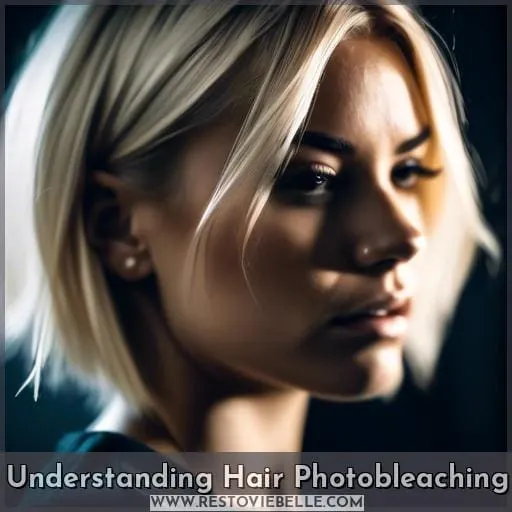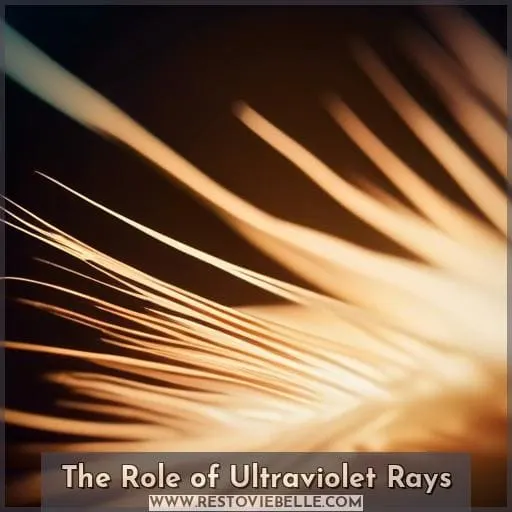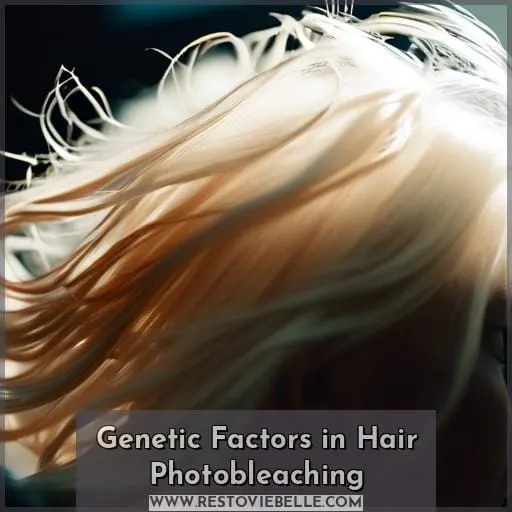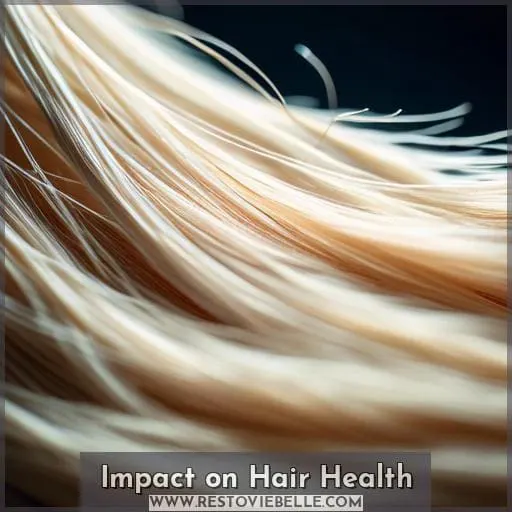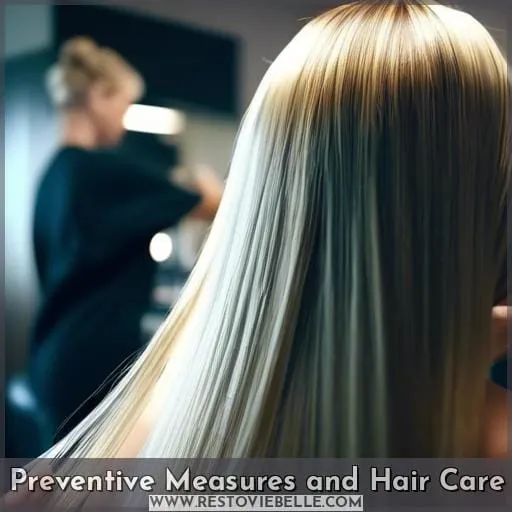This site is supported by our readers. We may earn a commission, at no cost to you, if you purchase through links.
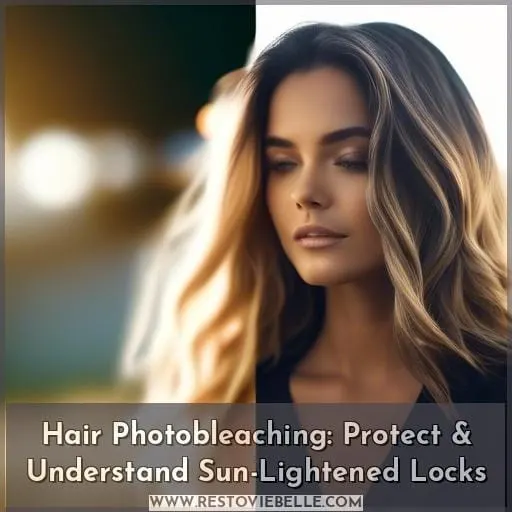 Nearly 72% of individuals with European ancestry report sun-induced hair lightening.
Nearly 72% of individuals with European ancestry report sun-induced hair lightening.
Hair photobleaching is a natural phenomenon where ultraviolet rays break down hair pigment.
You’re not alone in your quest to understand and manage this process. This article delves into the science behind hair photobleaching, explores genetic predispositions, and offers strategies to protect your locks from potential damage.
Embrace the innovation in hair care and gain control over your sun-lightened strands.
Table Of Contents
- Key Takeaways
- Understanding Hair Photobleaching
- The Role of Ultraviolet Rays
- Genetic Factors in Hair Photobleaching
- Impact on Hair Health
- Preventive Measures and Hair Care
- Frequently Asked Questions (FAQs)
- Can hair photobleaching be reversed, and if so, how?
- Does hair photobleaching affect the rate of hair growth or the hair growth cycle?
- Are there any long-term health risks associated with repeated hair photobleaching from sun exposure?
- How does hair photobleaching differ between hair that has been chemically treated (e.g., dyed or permed) and virgin hair?
- Can dietary changes or supplements influence the susceptibility of hair to photobleaching?
- Conclusion
Key Takeaways
- Sun exposure leads to hair photobleaching by breaking down melanin, the pigment responsible for hair color, resulting in lighter hair shades.
- Genetic factors, including 48 identified genetic markers, significantly influence an individual’s susceptibility to hair photobleaching, with those of European ancestry being more prone to experiencing sun-induced hair lightening.
- UV rays not only affect hair color but also degrade keratin, the protein that strengthens hair, leading to dry, brittle, and weaker hair strands.
- Preventive measures such as wearing wide-brimmed hats, using swimming caps, applying UV protection sprays, and employing overnight treatments can help mitigate the effects of photobleaching and maintain hair health.
Understanding Hair Photobleaching
Understanding hair photobleaching is like unraveling a mystery where sunlight plays the detective, breaking down pigment molecules in your hair as clues.
Imagine the sun’s ultraviolet rays as skilled agents, initiating a cascade of chemical reactions that gradually lighten your locks. This natural phenomenon doesn’t discriminate; whether you’re a sun worshiper or a casual outdoor enthusiast, your hair is susceptible to these changes.
The process is influenced by a cocktail of factors, including environmental triggers, your lifestyle choices, and even age-related changes. It’s a complex dance of pigment interactions within your hair, where the sun’s rays lead the tango, altering the natural color through a series of precise steps.
But here’s the twist: your genetic makeup is the choreographer, determining how susceptible your hair is to this lightening effect. So, while you might enjoy the sun-kissed highlights, remember, it’s a delicate balance between beauty and the underlying science of hair photobleaching.
The Role of Ultraviolet Rays
Continuing from the understanding of hair photobleaching, let’s delve into the nitty-gritty of how UV rays from the sun play the villain in this natural lightening process. Imagine the sun’s UV rays as tiny warriors, armed and ready to invade the fortress of your hair shaft.
Their mission? To break down melanin, the pigment that gives your hair its color. This siege on melanin doesn’t discriminate; whether your locks are curly, straight, thick, or thin, they’re all fair game for these relentless rays.
Now, you might think a little sun-kissed glow is harmless, but here’s the rub: UV exposure doesn’t just stop at altering your hair’s hue. It’s a double-edged sword that can also lead to hair damage, leaving your tresses dry, brittle, and singing a frizzy tune of distress.
So, while you’re out there soaking up the sun, remember that your hair is soaking up something too—a cocktail of UV that could turn your silky strands into a straw-like snarl. It’s a classic case of too much of a good thing, where your quest for those beachy highlights could end up in a hairy situation.
Genetic Factors in Hair Photobleaching
Recent research has identified 48 genetic markers that may influence your hair’s tendency to lighten, or photobleach, under the sun’s rays.
This phenomenon is particularly common among individuals with European ancestry, with over 72% of European-descended participants in a 23andMe study reporting sun-induced hair lightening.
The underlying process involves the degradation of melanin, the pigment responsible for hair color, which can vary significantly due to genetic factors.
Genetic Markers Identified
As we’ve peeled back the layers on how ultraviolet rays play a pivotal role in hair photobleaching, let’s dive into the genetic pool to understand why some of us might find our locks lightening more than others.
It turns out, your genes are throwing a party, and melanin’s invited—or not, depending on your ancestry and genetic variation.
- 48 genetic markers have been spotlighted, dancing along the double helix, influencing how your hair responds to the sun’s serenade.
- Pigmentation variation plays a significant role, with melanin types (pheomelanin and eumelanin) deciding whether your hair is more likely to catch the sun’s eye.
- European ancestry seems to have a VIP pass to this lightening show, thanks to evolution’s guest list.
- Melanin degradation under the UV spotlight leads to the main event: photobleaching.
So, if you’ve ever wondered why your summer fling with the sun leaves your hair a few shades lighter, you can thank (or blame) your genetic lineup for the invite.
European Ancestry Link
If you’ve got European roots, you might notice your hair playing a game of catch-me-if-you-can with the sun, lightening up after a summer outdoors. This isn’t just a quirky trait; it’s a genetic handshake between your ancestry and the sun’s rays.
European genes often carry a suitcase full of markers that say, Let’s lighten up! under the sun’s spotlight. This genetic predisposition means melanin, the pigment giving your hair its color, takes a little sunbath and decides to fade, leading to those sun-kissed highlights.
So, if your locks lighten with sun exposure, you can thank your European ancestors for passing down this light-hearted trait.
Melanin Degradation Impact
When you think about hair color, you’re really thinking about melanin production. It’s the backstage hero that gives your locks their hue. But here’s the twist: melanin isn’t just about aesthetics; it’s your hair’s personal bodyguard against the sun’s harsh rays.
Now, let’s dive into the nitty-gritty of how genetic variation and environmental factors play tug-of-war with your hair’s protective mechanisms.
- Melanin production is the maestro of your hair’s color symphony, conducting the blend of eumelanin and pheomelanin.
- Genetic variation is like a genetic lottery, doling out different melanin tickets to each of us.
- Environmental factors, the sneaky culprits, can fade your hair’s color like a beloved t-shirt in the sun.
- Protective mechanisms in your hair are like tiny umbrellas, shielding your strands from UV damage.
- Hair color isn’t just a static trait; it’s a dynamic story, evolving with age and sun exposure.
Impact on Hair Health
As we’ve explored the genetic predispositions to hair photobleaching, it’s crucial to pivot to how this natural quest for sun-kissed highlights can impact your hair’s health. Imagine the sun as a double-edged sword: while it gifts your locks with those sought-after lighter shades, it also wages war on your hair’s integrity.
- Chemical reactions unleashed by UV rays don’t just stop at altering hair color; they break down keratin, the very protein that keeps your hair strong and resilient.
- Your hair becomes a battleground, leaving it dry, brittle, and weaker. It’s like sending your hair on a marathon without any training – it’s bound to get hurt.
- The aftermath? Managing and styling becomes a Herculean task, with frizz and dullness often taking center stage, turning your dream of perfect beach waves into a frizzy nightmare.
But fear not! Understanding the science behind photobleaching empowers you to make informed decisions about your hair care. Remember, while the allure of natural highlights is tempting, the health of your hair should always take precedence.
Preventive Measures and Hair Care
To keep your sun-kissed locks vibrant and healthy, it’s crucial to arm yourself against the sneaky, strand-sapping effects of UV rays. Think of your hair care routine as your personal armor in the battle against the sun’s relentless siege.
| Preventive Measure | Product Type | Why It’s Your Mane’s Best Friend |
|---|---|---|
| Hat Trick | Wide-brimmed Hat | A stylish sentinel against UV assault, keeping those rays at bay. |
| Swim Smart | Swimming Cap | Your aquatic ally, warding off chlorine and saltwater saboteurs. |
| Liquid Shield | UV Protection Spray | Invisible cloak for your tresses, deflecting UV villains with ease. |
| Nighttime Nourishment | Overnight Treatment | Moonlight magic, repairing and rejuvenating while you dream. |
Frequently Asked Questions (FAQs)
Can hair photobleaching be reversed, and if so, how?
Hair photobleaching, caused by sun exposure, isn’t reversible, but don’t fret!
Your hair’s natural color can return as new hair grows in and you trim away the lightened ends.
Meanwhile, keep your locks under a hat to prevent further sun kisses.
Does hair photobleaching affect the rate of hair growth or the hair growth cycle?
Hair photobleaching doesn’t directly affect your hair growth rate or cycle. It’s the sun’s kiss on your locks, not a root issue.
But, overdoing it can weaken strands, making them seem like they’re growing slower due to breakage.
Keep it healthy, and your mane will continue its usual growth march.
Are there any long-term health risks associated with repeated hair photobleaching from sun exposure?
Repeated sun exposure leading to hair photobleaching doesn’t just fade your locks; it can weaken them, making them porous and frizzy.
While not directly linked to long-term health risks, it’s a sign to shield your mane from the sun’s kiss.
How does hair photobleaching differ between hair that has been chemically treated (e.g., dyed or permed) and virgin hair?
Chemically treated hair, already compromised by dyes and perms, may suffer more from photobleaching. It can become drier and weaker than virgin hair, which retains its natural resilience.
Can dietary changes or supplements influence the susceptibility of hair to photobleaching?
While there’s no magic bullet, your diet can indeed play a role in your hair’s health.
Nutrients counter oxidative stress, which is linked to hair photobleaching, so munching on the right vitamins and minerals might just be your mane’s knight in shining armor.
Conclusion
Ever wondered why your hair seems to have a mind of its own, especially under the summer sun? Understanding hair photobleaching is key to unlocking the secrets of your sun-lightened locks.
The sun’s ultraviolet rays, genetic predispositions, and the impact on hair health all play pivotal roles in this natural phenomenon. Armed with knowledge and the right preventive measures, you’re now equipped to protect your hair from potential damage while embracing its natural beauty.
